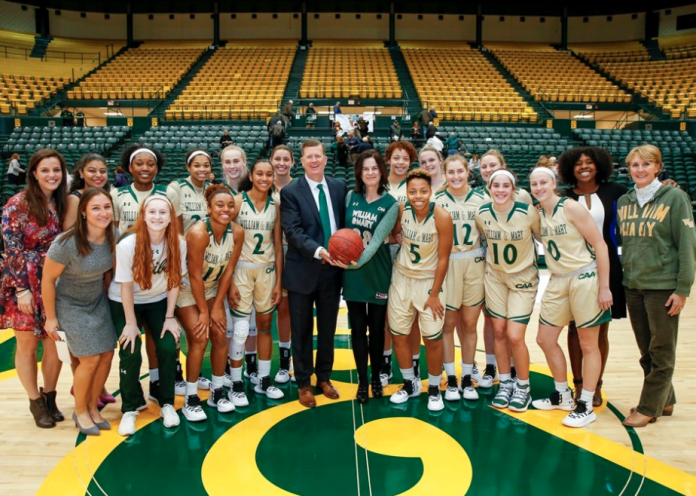William and Mary’s graduating seniors bemoaned in their 1918 yearbook that they would be “the last class to graduate from the old college before it is defiled by coeducation.” Despite the protests of their male peers, two dozen women enrolled in the class of 1922, and almost immediately formed a basketball team. Dec. 5, 2018, the women’s team celebrated the centennial anniversary of women’s basketball on campus with a historically accurate reenactment of an early basketball game.
In this 2018 game, the Tribe beat Richmond, 65-55. It was the Spiders that competed against the Tribe in the very first intercollegiate basketball game held in 1920. However, the journal of Martha Barksdale, a member of the College’s first female class, indicates that female students organized intramural games as early as the 1918-1919 academic year.
For the 24 women in the College’s first co-education class, participating in college life meant taking part in the basketball mania that was sweeping the nation.
“[Basketball] really spread like wildfire across the country,” Senior Director of Alumni Engagement and Inclusion Initiatives Valerie Cushman said. “Women’s colleges and the few co-ed institutions at that time all started playing this game of basketball.”
Female athletes were expected to comport themselves in a ladylike manner at all times, even while on the court, which required modifications to be made to the rowdier men’s game. For example, women were prohibited from grabbing the ball out of an opponent’s hands, as doing so was considered impolite and aggressive; falling down was a foul.
In addition to the behavioral concerns polite society had about these female athletes, many physicians at the time had reservations about the physical effects such intense exercise would have on women. Female basketball players were allowed to dribble the ball no more than three times, which was a ploy to restrict their movement up and down the court, as it was thought that too much running was bad for the reproductive organs and would affect one’s childbearing ability later in life.
While their male peers used either the underhanded shot or the two-handed set shot, female players were the first to employ the one-handed set shot that is widely used by both genders today. The one-handed set shot originated in the women’s game because doctors were worried that other methods of shooting would flatten a woman’s breasts. It would take 30 years for the men to adopt the more accurate one-handed set shot.
Despite these restrictive rules, women flocked to the game as players, coaches and spectators.
“There are pictures of women college basketball players playing in front of thousands of fans,” Cushman said. “Men were not allowed to watch. They would bar the doors.”
There were plenty of men in the audience to watch the reenactment of the first women’s basketball game played at the College. Female athletes from the College’s volleyball and field hockey teams, among others, participated in the reenactment. By and large, they considered it an opportunity to pay homage to the pioneering women who made their own teams possible.
“I think it’s interesting to see in this short time how far women in athletics have come,” freshman volleyball player Anne Louise Seekford said.
While the female participants of the reenactment feel that they are treated equally in relation to their male counterparts, that wasn’t always the case at the College.
“We didn’t have the same facilities,” former point guard Nancy Scott ’81 said. “We traveled in vans, and the coaches had to drive them. The men traveled in buses. … It was not equal.”
Scott credits Millie West, the athletic director during Scott’s time at the College, with leading the charge for the equal treatment of female athletes. West used her role as athletic director to help raise funds for the female sports teams at the College.
“She was so thoughtful and relentless in her pursuit for women,” Scott said. “What you see today at William and Mary has really been on people like Millie and others who really fought hard to get the things that men had for the women.”
The significance of women’s participation in athletics goes beyond the rights outlined in Title IX. The women in the class of 1922 were ridiculed by their peers and excluded from nearly every on-campus organization. Forming a basketball team gave Barksdale and her fellow female students a way to show their detractors that women were here to stay. Sports provided a community for the women on campus rather than letting them suffer in isolation; the basketball team was a built-in support system.
The women of the College have come a long way since 1918. The members of the first intramural basketball team didn’t even have the right to vote. Their participation on campus was scorned, but they refused to be deterred. Their persistence made it possible for generations of women that would come after them to continue to strike blows against gender inequality.
Current players on the women’s basketball team are grateful for the legacy of perseverance left behind by the members of the College’s inaugural team.
“There’s not a lot of teams out there that can say they’ve existed for one hundred years, especially not women’s teams,” senior guard Misha Collins said. “I’m proud to know that there are women who came before me who did the exact same thing.”

